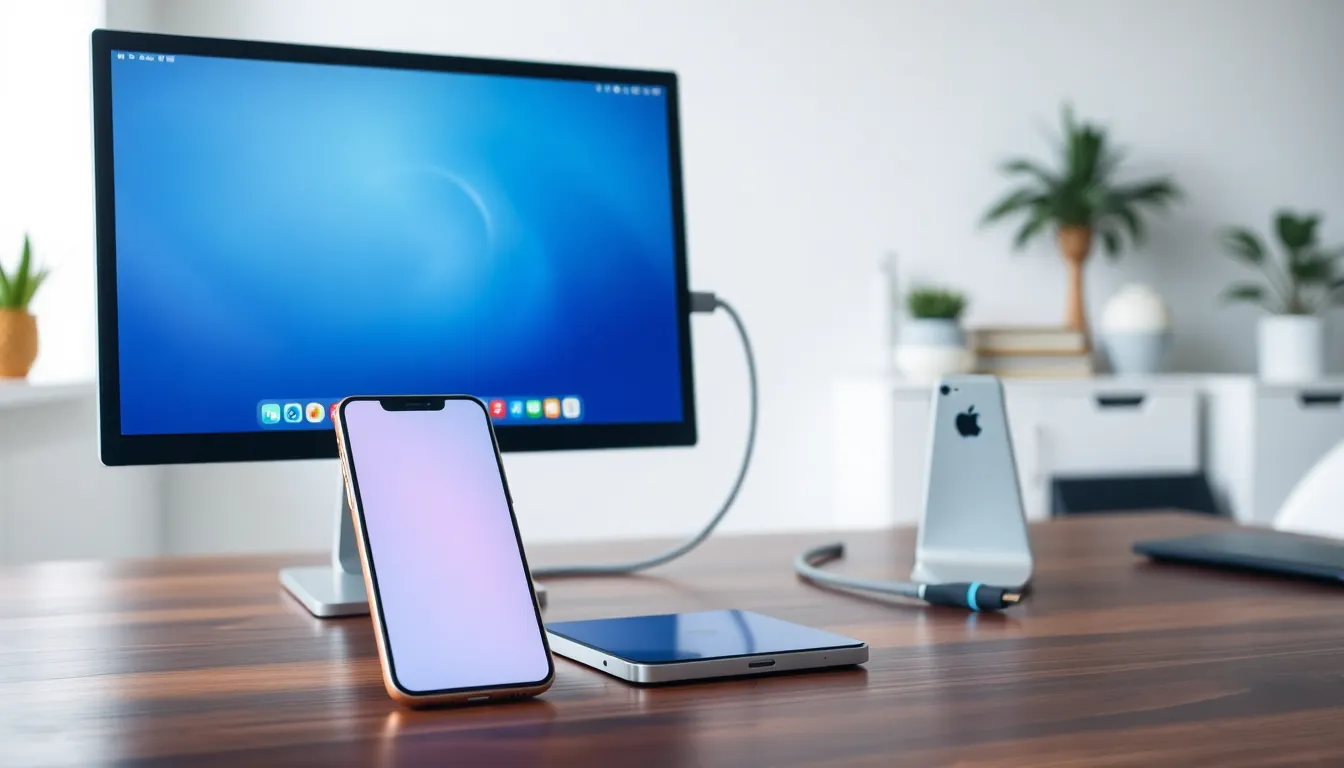Ever felt like your iPhone’s screen is a bit too cozy? Maybe it’s time to expand your horizons—literally! Adding another screen to your iPhone isn’t just a techie dream; it’s a game-changer for multitasking. Picture this: you’re scrolling through your favorite social media while watching a cooking tutorial. Sounds like a recipe for success, right?
Table of Contents
ToggleUnderstanding iPhone Screens
Users often explore different options when adding another screen to their iPhone. This section outlines the types of screens available and their specific benefits.
Types of Screens Available
Tablets and laptops frequently serve as second screens. Wireless displays also connect to the iPhone for enhanced usability. Smart TVs allow for seamless viewing experiences, enabling users to mirror their screens. Additional devices come with various sizes and capabilities, accommodating diverse user needs. A combination of these screens can transform multitasking methods, offering flexibility based on individual preferences.
Benefits of Adding Another Screen
Improved productivity ranks high among the benefits. Multitasking becomes effortless when users can browse social media and watch videos concurrently. Enhanced visibility often occurs, allowing for better focus on essential tasks. Users frequently emphasize reduced eye strain when screens are larger and positioned at optimal angles. Increased efficiency is evident as apps can run side by side, streamlining workflows. Additional screens provide unique experiences for gaming, browsing, and content creation, making iPhone usage more versatile.
Preparing Your iPhone

Preparing your iPhone for an additional screen involves checking compatibility and ensuring that it runs the latest software version. These steps provide a smoother experience when implementing the new setup.
Checking Compatibility
Confirming compatibility ensures your iPhone connects with the additional screen. Apple devices generally require an iPhone 6s or newer to support multiple display interfaces effectively. Verify that the additional screen supports AirPlay or screen mirroring if using a wireless display. Check for supported protocols and connections like HDMI or USB-C for wired options. Numerous apps facilitate this connectivity, so reviewing their requirements can also help in choosing the right configuration.
Updating Your iPhone
Updating software keeps the device functioning optimally. Navigate to the Settings app, tap on General, then choose Software Update. Installing the latest version, particularly iOS 14.0 or later, enhances compatibility with additional screens. Updating addresses potential bugs and enhances security features. Maintaining software ensures proper communication between your iPhone and the additional display, significantly improving the overall experience.
How to Add Another Screen on iPhone
Adding another screen on an iPhone enhances productivity and the user experience, making it easier to multitask and enjoy content.
Using Screen Mirroring
Screen mirroring connects the iPhone to compatible devices, such as smart TVs or wireless displays. Access Control Center by swiping down from the top right corner of the screen. Tap on Screen Mirroring and choose a device from the list. Screen mirroring allows users to display content in real time, perfect for presentations or movie nights. Ensure both devices are on the same Wi-Fi network for successful connection. It’ll simplify sharing photos, videos, and apps on a larger screen, enhancing visibility and interaction.
Utilizing External Monitors
External monitors offer a larger workspace, ideal for productivity tasks. Use a Lightning to HDMI adapter to connect the iPhone directly to a monitor. Connect the adapter to the iPhone, then to the monitor using an HDMI cable. External monitors support various resolutions, providing clear visuals for video conferencing or graphic design. Some monitors also support wireless connections via AirPlay, enabling cable-free operation. Consider using a USB-C hub if the monitor has USB-C inputs, optimizing connectivity.
Tips for Managing Multiple Screens
Managing multiple screens enhances productivity and user experience. Users can adopt specific strategies for effective interaction.
Organizing Your Home Screen
Arranging apps is crucial for swift access. Grouping similar apps together simplifies tasks, such as placing social media apps alongside browsing tools. Creating dedicated folders helps minimize clutter, allowing for a seamless transition between activities. Users can also utilize widgets to display essential information at a glance. Prioritizing frequently used apps ensures efficiency while multitasking. Keeping the most important apps on the home screen makes for easier navigation, especially during high-demand sessions.
Optimizing App Use
Utilizing apps across screens maximizes functionality. Many productivity apps support multi-window views, permitting users to work on two tasks simultaneously. Choosing applications that sync easily across devices, such as note-taking or calendar tools, facilitates a better workflow. Notifications from various apps should be managed to avoid distractions. Users can customize alert settings, ensuring only important notifications interrupt their work. Lastly, understanding app split-screen capabilities enhances multitasking, enabling users to juggle tasks without losing focus.
Adding another screen to an iPhone can significantly enhance the user experience. Whether for work or leisure the ability to multitask opens up new possibilities. By connecting to tablets laptops or smart TVs users can enjoy seamless transitions between tasks and activities.
With the right setup and organization users can streamline their workflows and reduce distractions. Embracing these tools not only boosts productivity but also makes everyday tasks more enjoyable. As technology continues to evolve staying updated on the latest features and compatibility options will ensure users get the most out of their devices.




